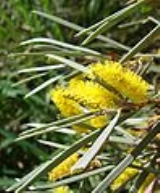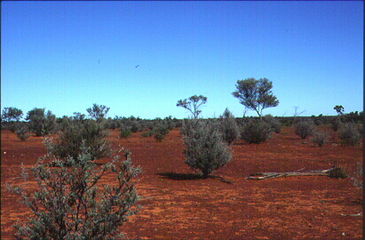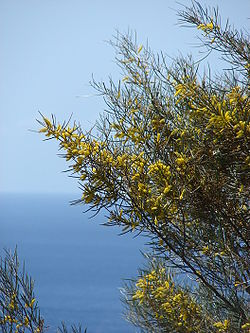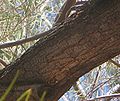
Mulga
Encyclopedia
Acacia aneura, commonly known as Mulga
or True Mulga, is a shrub or small tree native to arid outback
Australia
of areas such as the Western Australian Mulga shrublands
.
 Mulga is highly variable, in form, in height, and in shape of phyllodes and seed pods. It can form dense forest
Mulga is highly variable, in form, in height, and in shape of phyllodes and seed pods. It can form dense forest
up to 15 metres high, or small, almost heath-like low shrubs spread well apart. Most commonly, it is a tall shrub. Because it is so variable, the taxonomy
of the Mulga has been studied extensively, and although it is likely to be split into several species eventually, there is as yet no consensus on how or even if this should be done. Although generally small in size, Mulga is long-lived, a typical life span
for a tree undisturbed by fire is in the order of 200 to 300 years.
Mulga has developed extensive adaptations to the Australian desert
. Like many Acacia
species, Mulga has thick-skinned phyllodes. These are optimised for low water loss, with a high oil content, sunken stomata, and a profusion of tiny hairs to reduce transpiration
. During dry periods, a Mulga drops much of its foliage to the ground, which provides an extra layer of mulch
and from where the nutrients can be recycled.
Like most Australian Acacia species, mulga is thornless. The needle-like phyllodes stand erect to avoid as much of the midday sun as possible and capture the cooler morning and evening light. Any rain that falls is channeled down the phyllodes and branches to be collected in the soil
immediately next to the trunk, providing the tree with a more than threefold increase in effective rainfall. Mulga roots penetrate far into the soil to find deep moisture. The roots also harbour bacteria
that fix
atmospheric nitrogen
and thus help deal with the very old, nutrient poor soils the species grows in.
and mulga co-dominant tussock grassland
s cover roughly 20% of the Australian continent, or about 1.5 million square kilometres. The mean
rainfall for much of the habitat
for Acacia aneura in Australia is roughly 200–250 mm/year, but it goes to as high as 500 mm/year in New South Wales
and Queensland
. The lowest mean rainfall that it grows in is about 50–60 mm/year. Both summer and winter rainfall are necessary to maintain mulga and the species is absent from semiarid regions that experience summer or winter drought
.
Mulga scrub is distinctive and widespread, with the Mulga Lands
of eastern Australia defined as a specific bioregion. The dominant species in these woodland
s is Mulga with poplar box (Eucalyptus populnea
) forming an increasingly important co-dominant in the eastern districts. The extent of ground cover in mulga woodlands varies with canopy density of the overstorey, becoming almost non-existent in extremely dense stands. In more open stands the herbaceous layer consists of wire grasses (Aristida spp), Mulga oats (Monocather sp.), Mulga mitchell (Thyridolepis
sp.), Wanderrie (Eriachne
spp.), finger grasses (Digitaria
spp.) and love grasses (Eragrostis spp.). Various other woody species are also significant in mulga woodlands, particularly hop bushes (Dodonaea
spp.), Eremophila
and Cassia (Senna spp.).
 In contrast to the eucalypt
In contrast to the eucalypt
woodlands that dominate much of Australia, mulga woodlands are not well adapted to regular fire
and species in mulga communities vary in their ability to survive fires. Many species, including mulga itself, have a very limited ability to resprout after fire, and rely instead on mechanisms of seed production for species survival. Many plants produce hard, woody fruits or seeds, which can not only survive intense heat but may require the stimulus of fire to scarify and promote germination
. Long-lived seed store in soil is also common in these woodlands.
There are a number of recognised varieties:
plantations as a host tree
 The tree's flowers provide forage
The tree's flowers provide forage
for bee
s, especially when there is enough water available.
industry. Despite containing considerable amounts of indigestible tannin
s, mulga leaves are a valuable fodder
source, particularly in times of drought, as it is palatable to stock and provides up to 12% crude protein
.
 The seeds of Acacia aneura were used to make seedcakes. The mulga apple
The seeds of Acacia aneura were used to make seedcakes. The mulga apple
is an insect gall
commonly eaten by Aboriginal people. Mulga tree gum (Ngkwarle alkerampwe in the Arrernte language) is a type of lerp
scale found on mulga branches. It provides a tasty honey
-like treat for Indigneous people.
 Wood from Acacia aneura stands up very well to being buried in soil and it is used for posts. The wood has a density
Wood from Acacia aneura stands up very well to being buried in soil and it is used for posts. The wood has a density
of about 850–1100 kg/m3.
. Very good quality charcoal
can be produced from it.
; the wood was a good hardwood
for making various implements, such as digging stick
s and woomeras
.
Mulga
Acacia aneura, commonly known as Mulga or True Mulga, is a shrub or small tree native to arid outback Australia of areas such as the Western Australian Mulga shrublands.-Description:...
or True Mulga, is a shrub or small tree native to arid outback
Outback
The Outback is the vast, remote, arid area of Australia, term colloquially can refer to any lands outside the main urban areas. The term "the outback" is generally used to refer to locations that are comparatively more remote than those areas named "the bush".-Overview:The outback is home to a...
Australia
Australia
Australia , officially the Commonwealth of Australia, is a country in the Southern Hemisphere comprising the mainland of the Australian continent, the island of Tasmania, and numerous smaller islands in the Indian and Pacific Oceans. It is the world's sixth-largest country by total area...
of areas such as the Western Australian Mulga shrublands
Western Australian Mulga shrublands
The Western Australian Mulga shrublands is a large dry World Wildlife Fund ecoregion of inland Western Australia .-Location and description:This is a hot, dry area with little rainfall....
.
Description

Forest
A forest, also referred to as a wood or the woods, is an area with a high density of trees. As with cities, depending where you are in the world, what is considered a forest may vary significantly in size and have various classification according to how and what of the forest is composed...
up to 15 metres high, or small, almost heath-like low shrubs spread well apart. Most commonly, it is a tall shrub. Because it is so variable, the taxonomy
Taxonomy
Taxonomy is the science of identifying and naming species, and arranging them into a classification. The field of taxonomy, sometimes referred to as "biological taxonomy", revolves around the description and use of taxonomic units, known as taxa...
of the Mulga has been studied extensively, and although it is likely to be split into several species eventually, there is as yet no consensus on how or even if this should be done. Although generally small in size, Mulga is long-lived, a typical life span
Life expectancy
Life expectancy is the expected number of years of life remaining at a given age. It is denoted by ex, which means the average number of subsequent years of life for someone now aged x, according to a particular mortality experience...
for a tree undisturbed by fire is in the order of 200 to 300 years.
Mulga has developed extensive adaptations to the Australian desert
Desert
A desert is a landscape or region that receives an extremely low amount of precipitation, less than enough to support growth of most plants. Most deserts have an average annual precipitation of less than...
. Like many Acacia
Acacia
Acacia is a genus of shrubs and trees belonging to the subfamily Mimosoideae of the family Fabaceae, first described in Africa by the Swedish botanist Carl Linnaeus in 1773. Many non-Australian species tend to be thorny, whereas the majority of Australian acacias are not...
species, Mulga has thick-skinned phyllodes. These are optimised for low water loss, with a high oil content, sunken stomata, and a profusion of tiny hairs to reduce transpiration
Transpiration
Transpiration is a process similar to evaporation. It is a part of the water cycle, and it is the loss of water vapor from parts of plants , especially in leaves but also in stems, flowers and roots. Leaf surfaces are dotted with openings which are collectively called stomata, and in most plants...
. During dry periods, a Mulga drops much of its foliage to the ground, which provides an extra layer of mulch
Mulch
In agriculture and gardening, is a protective cover placed over the soil to retain moisture, reduce erosion, provide nutrients, and suppress weed growth and seed germination. Mulching in gardens and landscaping mimics the leaf cover that is found on forest floors....
and from where the nutrients can be recycled.
Like most Australian Acacia species, mulga is thornless. The needle-like phyllodes stand erect to avoid as much of the midday sun as possible and capture the cooler morning and evening light. Any rain that falls is channeled down the phyllodes and branches to be collected in the soil
Soil
Soil is a natural body consisting of layers of mineral constituents of variable thicknesses, which differ from the parent materials in their morphological, physical, chemical, and mineralogical characteristics...
immediately next to the trunk, providing the tree with a more than threefold increase in effective rainfall. Mulga roots penetrate far into the soil to find deep moisture. The roots also harbour bacteria
Bacteria
Bacteria are a large domain of prokaryotic microorganisms. Typically a few micrometres in length, bacteria have a wide range of shapes, ranging from spheres to rods and spirals...
that fix
Nitrogen fixation
Nitrogen fixation is the natural process, either biological or abiotic, by which nitrogen in the atmosphere is converted into ammonia . This process is essential for life because fixed nitrogen is required to biosynthesize the basic building blocks of life, e.g., nucleotides for DNA and RNA and...
atmospheric nitrogen
Nitrogen
Nitrogen is a chemical element that has the symbol N, atomic number of 7 and atomic mass 14.00674 u. Elemental nitrogen is a colorless, odorless, tasteless, and mostly inert diatomic gas at standard conditions, constituting 78.08% by volume of Earth's atmosphere...
and thus help deal with the very old, nutrient poor soils the species grows in.
Habitat and ecology
Mulga savannaSavanna
A savanna, or savannah, is a grassland ecosystem characterized by the trees being sufficiently small or widely spaced so that the canopy does not close. The open canopy allows sufficient light to reach the ground to support an unbroken herbaceous layer consisting primarily of C4 grasses.Some...
and mulga co-dominant tussock grassland
Grassland
Grasslands are areas where the vegetation is dominated by grasses and other herbaceous plants . However, sedge and rush families can also be found. Grasslands occur naturally on all continents except Antarctica...
s cover roughly 20% of the Australian continent, or about 1.5 million square kilometres. The mean
Mean
In statistics, mean has two related meanings:* the arithmetic mean .* the expected value of a random variable, which is also called the population mean....
rainfall for much of the habitat
Habitat
* Habitat , a place where a species lives and grows*Human habitat, a place where humans live, work or play** Space habitat, a space station intended as a permanent settlement...
for Acacia aneura in Australia is roughly 200–250 mm/year, but it goes to as high as 500 mm/year in New South Wales
New South Wales
New South Wales is a state of :Australia, located in the east of the country. It is bordered by Queensland, Victoria and South Australia to the north, south and west respectively. To the east, the state is bordered by the Tasman Sea, which forms part of the Pacific Ocean. New South Wales...
and Queensland
Queensland
Queensland is a state of Australia, occupying the north-eastern section of the mainland continent. It is bordered by the Northern Territory, South Australia and New South Wales to the west, south-west and south respectively. To the east, Queensland is bordered by the Coral Sea and Pacific Ocean...
. The lowest mean rainfall that it grows in is about 50–60 mm/year. Both summer and winter rainfall are necessary to maintain mulga and the species is absent from semiarid regions that experience summer or winter drought
Drought
A drought is an extended period of months or years when a region notes a deficiency in its water supply. Generally, this occurs when a region receives consistently below average precipitation. It can have a substantial impact on the ecosystem and agriculture of the affected region...
.
Mulga scrub is distinctive and widespread, with the Mulga Lands
Mulga Lands
The Mulga Lands are an Interim Biogeographic Regionalisation for Australia region of eastern Australia consisting of dry sandy plains scattered with mulga trees.-Location and description:...
of eastern Australia defined as a specific bioregion. The dominant species in these woodland
Woodland
Ecologically, a woodland is a low-density forest forming open habitats with plenty of sunlight and limited shade. Woodlands may support an understory of shrubs and herbaceous plants including grasses. Woodland may form a transition to shrubland under drier conditions or during early stages of...
s is Mulga with poplar box (Eucalyptus populnea
Eucalyptus populnea
Eucalyptus populnea, commonly known as Poplar box or Bimble box is an endemic tree of Australia. It is found in central and coastal Queensland to northern New South Wales. It can reach up to 25 meters tall and forms extensive open-forest communities in arid and sem-arid regions...
) forming an increasingly important co-dominant in the eastern districts. The extent of ground cover in mulga woodlands varies with canopy density of the overstorey, becoming almost non-existent in extremely dense stands. In more open stands the herbaceous layer consists of wire grasses (Aristida spp), Mulga oats (Monocather sp.), Mulga mitchell (Thyridolepis
Thyridolepis
Thyridolepis is a genus of grass in the Poaceae family.-External links:*...
sp.), Wanderrie (Eriachne
Eriachne
Eriachne is a genus of grass in the Poaceae family found in areas such as the Western Australian Mulga shrublands ecoregion. .-External links:*...
spp.), finger grasses (Digitaria
Digitaria
Digitaria is a genus of about 300 species of grass native to tropical and warm temperate regions. Common names include crabgrass, finger-grass, and fonio. They are slender monocotyledonous annual and perennial lawn, pasture, and forage plants; some are often considered lawn pests...
spp.) and love grasses (Eragrostis spp.). Various other woody species are also significant in mulga woodlands, particularly hop bushes (Dodonaea
Dodonaea
Dodonaea is a genus of about 70 species of flowering plants in the soapberry family, Sapindaceae, with a cosmopolitan distribution in tropical, subtropical and warm temperate regions of Africa, the Americas, southern Asia and Australasia. By far the highest species diversity is in Australia...
spp.), Eremophila
Eremophila (plant)
Eremophila is a genus of plants of the family Scrophulariaceae, with species known by the common names of Emu Bush, Poverty Bush or Fuchsia Bush. Currently, there are 215 recognised species, all of which are endemic to Australia...
and Cassia (Senna spp.).

Eucalypt
Eucalypts are woody plants belonging to three closely related genera:Eucalyptus, Corymbia and Angophora.In 1995 new evidence, largely genetic, indicated that some prominent Eucalyptus species were actually more closely related to Angophora than to the other eucalypts; they were split off into the...
woodlands that dominate much of Australia, mulga woodlands are not well adapted to regular fire
Fire
Fire is the rapid oxidation of a material in the chemical process of combustion, releasing heat, light, and various reaction products. Slower oxidative processes like rusting or digestion are not included by this definition....
and species in mulga communities vary in their ability to survive fires. Many species, including mulga itself, have a very limited ability to resprout after fire, and rely instead on mechanisms of seed production for species survival. Many plants produce hard, woody fruits or seeds, which can not only survive intense heat but may require the stimulus of fire to scarify and promote germination
Germination
Germination is the process in which a plant or fungus emerges from a seed or spore, respectively, and begins growth. The most common example of germination is the sprouting of a seedling from a seed of an angiosperm or gymnosperm. However the growth of a sporeling from a spore, for example the...
. Long-lived seed store in soil is also common in these woodlands.
There are a number of recognised varieties:
- A. a. var. aneuraAcacia aneura var. aneuraAcacia aneura var. aneura is a shrub or tree which grows from 4 m to 6 m in height. It is native to Australia-External links:*...
- A. a. var. argenteaAcacia aneura var. argenteaAcacia aneura var. argentea is a tree which grows to 7 m high. It is native to Australia.-External links:*...
- A. a. var. fuligineaAcacia aneura var. fuligineaAcacia aneura var. fuliginea is a perennial tree which is native to Western Australia.-External links:*...
- A. a. var. intermediaAcacia aneura var. intermediaAcacia aneura var. intermedia is a perennial shrub or tree native to Australia.This variety is a form of the Mulga, Acacia aneura, a relatively long-lived species of genus Acacia.-External links:* *...
- A. a. var. macrocarpaAcacia aneura var. macrocarpaAcacia aneura var. macrocarpa is a perennial shrub native to Australia. Commonly found in the Northwest Region of Australia....
- A. a. var. majorAcacia aneura var. majorAcacia aneura var. major is a perennial tree native to Australia....
- A. a. var. microcarpaAcacia aneura var. microcarpaAcacia aneura var. microcarpa is a perennial shrub or tree native to Australia....
- A. a. var. pilbaranaAcacia aneura var. pilbaranaAcacia aneura var. pilbarana is a perennial shrub native to Australia....
- A. a. var. tenuisAcacia aneura var. tenuisAcacia aneura var. tenuis is a perennial tree native to Australia....
Host tree
Can be planted in relation to SandalwoodSantalum spicatum
Santalum spicatum, a species known as Australian sandalwood, is a tree native to semi-arid areas at the edge of Southwest Australia. It is traded as sandalwood and its valuable oil has been used as an aromatic, a medicine and a food source. S...
plantations as a host tree
Bee forage

Forage (honeybee)
For bees, their forage or food supply consists of nectar and pollen from blooming plants within flight range. The forage sources for honey bees are an important consideration for beekeepers. In order to determine where to locate hives for maximum honey production and brood one must consider the...
for bee
Bee
Bees are flying insects closely related to wasps and ants, and are known for their role in pollination and for producing honey and beeswax. Bees are a monophyletic lineage within the superfamily Apoidea, presently classified by the unranked taxon name Anthophila...
s, especially when there is enough water available.
Fodder
Mulga is of great economic important to Australia, especially the pastoralPastoralism
Pastoralism or pastoral farming is the branch of agriculture concerned with the raising of livestock. It is animal husbandry: the care, tending and use of animals such as camels, goats, cattle, yaks, llamas, and sheep. It may have a mobile aspect, moving the herds in search of fresh pasture and...
industry. Despite containing considerable amounts of indigestible tannin
Tannin
A tannin is an astringent, bitter plant polyphenolic compound that binds to and precipitates proteins and various other organic compounds including amino acids and alkaloids.The term tannin refers to the use of...
s, mulga leaves are a valuable fodder
Fodder
Fodder or animal feed is any agricultural foodstuff used specifically to feed domesticated livestock such as cattle, goats, sheep, horses, chickens and pigs. Most animal feed is from plants but some is of animal origin...
source, particularly in times of drought, as it is palatable to stock and provides up to 12% crude protein
Protein
Proteins are biochemical compounds consisting of one or more polypeptides typically folded into a globular or fibrous form, facilitating a biological function. A polypeptide is a single linear polymer chain of amino acids bonded together by peptide bonds between the carboxyl and amino groups of...
.
Food

Mulga apple
The mulga apple, is an Australian bush tucker food, often eaten by Aborigines of Central Australia.The mulga apple is in fact a combination of plant and animal; the insect gall grows inside the wood of the mulga tree ....
is an insect gall
Gall
Galls or cecidia are outgrowths on the surface of lifeforms caused by invasion by other lifeforms, such as parasites or bacterial infection. Plant galls are abnormal outgrowths of plant tissues and can be caused by various parasites, from fungi and bacteria, to insects and mites...
commonly eaten by Aboriginal people. Mulga tree gum (Ngkwarle alkerampwe in the Arrernte language) is a type of lerp
Lerp (biology)
In biology, a lerp is a structure of crystallized honeydew produced by larvae of psyllid insects as a protective cover.-Host plants:Some of the host plants on which lerp is often found include:* Eucalyptus dumosa...
scale found on mulga branches. It provides a tasty honey
Honey
Honey is a sweet food made by bees using nectar from flowers. The variety produced by honey bees is the one most commonly referred to and is the type of honey collected by beekeepers and consumed by humans...
-like treat for Indigneous people.
Construction

Density
The mass density or density of a material is defined as its mass per unit volume. The symbol most often used for density is ρ . In some cases , density is also defined as its weight per unit volume; although, this quantity is more properly called specific weight...
of about 850–1100 kg/m3.
Fuel
The wood is very good as firewoodFirewood
Firewood is any wood-like material that is gathered and used for fuel. Generally, firewood is not highly processed and is in some sort of recognizable log or branch form....
. Very good quality charcoal
Charcoal
Charcoal is the dark grey residue consisting of carbon, and any remaining ash, obtained by removing water and other volatile constituents from animal and vegetation substances. Charcoal is usually produced by slow pyrolysis, the heating of wood or other substances in the absence of oxygen...
can be produced from it.
Implements
Mulga was a vital tree to Indigenous Australians in Central AustraliaCentral Australia
Central Australia/Alice Springs Region is one of the five regions in the Northern Territory. The term Central Australia is used to describe an area centred on Alice Springs in Australia. It is sometimes referred to as Centralia; likewise the people of the area are sometimes called Centralians...
; the wood was a good hardwood
Hardwood
Hardwood is wood from angiosperm trees . It may also be used for those trees themselves: these are usually broad-leaved; in temperate and boreal latitudes they are mostly deciduous, but in tropics and subtropics mostly evergreen.Hardwood contrasts with softwood...
for making various implements, such as digging stick
Digging stick
In archaeology and anthropology a digging stick is the term given to a variety of wooden implements used primarily by subsistence-based cultures to dig out underground food such as roots and tubers or burrowing animals and anthills...
s and woomeras
Woomera (spear-thrower)
A woomera is an Australian Aboriginal spear-throwing device used for when there is a greater distance to be overcome. It is highly efficient and made of wood. Similar to an atlatl, it enables a spear to travel much further than by arm strength alone...
.

